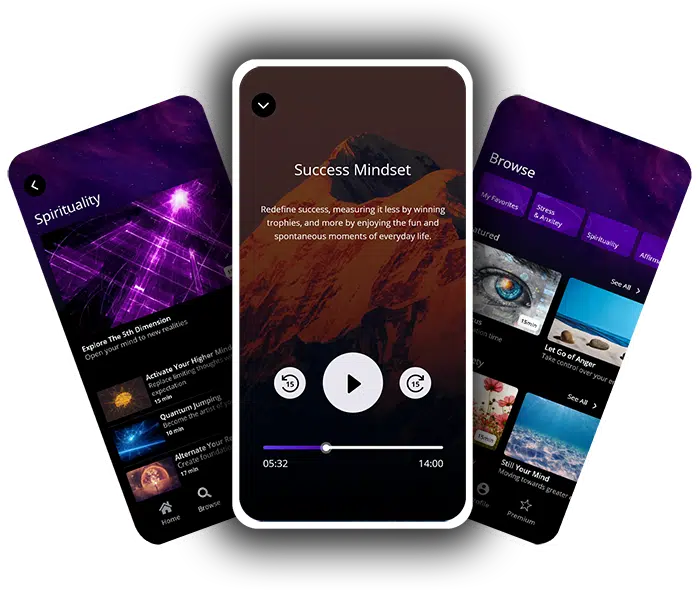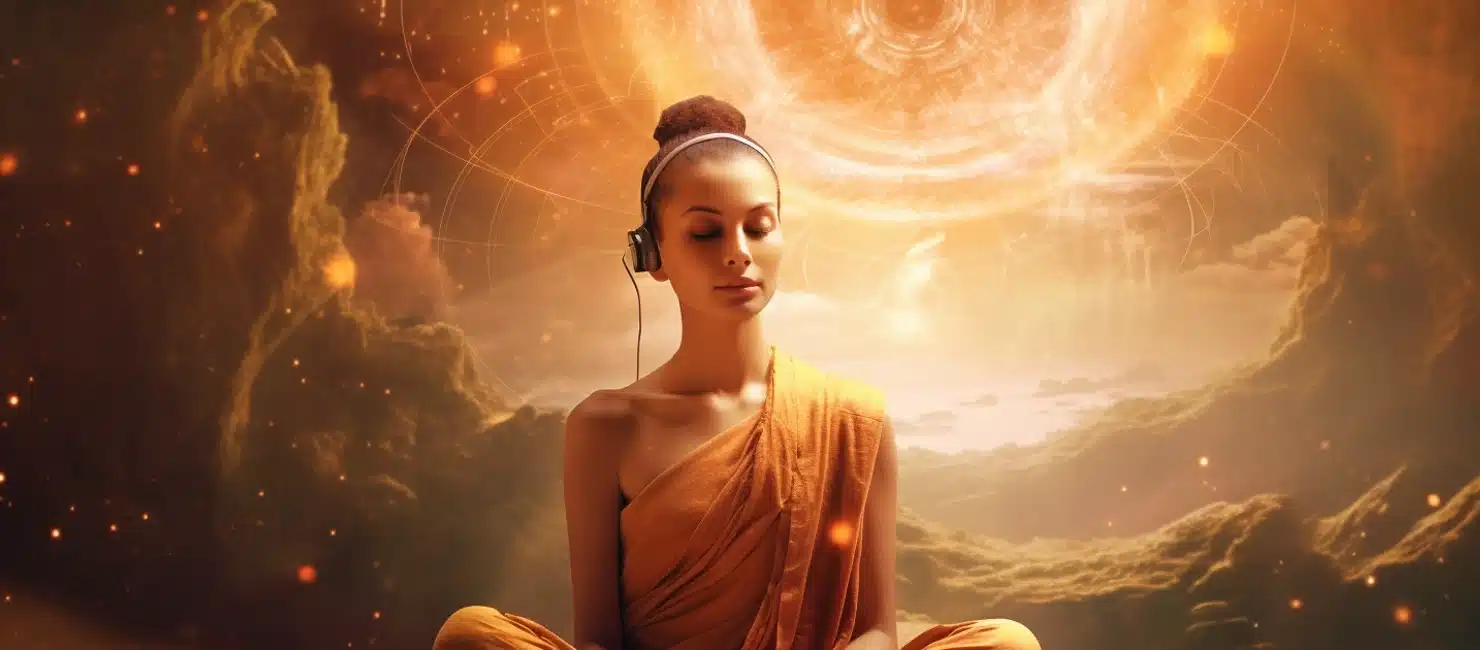Are you struggling to maintain focus during your meditation practice? Object meditation, a technique where you concentrate on a specific item, may be the solution. This blog post will help you pick an apt object for meditation and teach you how to incorporate it into your practice for improved focus and reduced stress.
Ready to dive in? Let’s get started win an incredibly powerful guided meditation that uses guided imagery as object of meditation!

Unleash Your True Potential!
Explore the world of meditation with our powerful guided sessions crafted to bring peace and strength to your spirit.
But first, let’s ensure our sessions are the perfect fit for you.
Take our short quiz to find out!
Table of contents
What is Object of Meditation?
Object meditation is centered on focusing your awareness on a specific object, enabling you to develop the capacity to remain in the present and engage in nonjudgmental observation. This form of meditation serves as a potent technique for nurturing mindfulness and fostering inner tranquility.
In simper terms object of meditation means the point you focus on while meditating. It’s like picking a spot to rest your mind. A lot of things can be an object for your meditation. Some people use their breath, sounds they hear, or even images to keep their minds steady during meditation.
The goal here is not just about mulling over something with your eyes locked onto it. Object meditation involves more than that. It calls for keen mindfulness and total concentration while observing the chosen item without judgment or distraction.
For instance, some might choose a fresh rose as their object and think about its beauty in great detail throughout the routine. Any object can serve as long as it brings calmness and holds one’s interest.
How to Choose an Object of Meditation

When choosing an object of meditation, consider different types such as the breath, sound, or visual objects.
Different types of objects (breath, sound, visual)
You can pick different things to focus on when you do object meditation. Here are some examples:
- Breath: You breathe all the time, so it’s easy to use this as your focus. Just pay attention to how it feels to breathe in and out.
- Sound: Sounds around you can also help you meditate. This could be a soft song or even the sound of rain.
- Visual: You can use something you see as your meditation object. It could be a flower, a picture, or even a color.
Considerations for selecting an object
Picking the right object for your meditation is a vital step. It can shape how well you meditate. Here are some things to keep in mind:
- The object should be easy to focus on.
- Make sure it doesn’t distract you.
- Go for an object that makes you feel calm and at peace.
- Pick an object that fits with your lifestyle and beliefs.
- The best object for meditation helps you to stay in the present moment.
- Try out different objects like breath, mantra, or sensations in the body until you find what works best for you.
- Some people use a Sanskrit word in transcendental meditation as their focus point.
Different Objects of Meditation
There are several different objects of meditation that you can choose to focus on during your practice. Some common objects include the breath, a mantra or chant, a visual object or image, and sensations in the body.
Breath

Unleash Your True Potential!
Explore the world of meditation with our powerful guided sessions crafted to bring peace and strength to your spirit.
But first, let’s ensure our sessions are the perfect fit for you.
Take our short quiz to find out!
The breath is a common and important object of meditation. It is often chosen because it is always available to focus on, and it continuously changes, giving us something to pay attention to.
Many calming meditation practices involve focusing on the breath, as it can help bring about a sense of peace and relaxation. Regular practice of breathing meditation techniques can also have long-term benefits for our physical health and overall well-being.
Learning to meditate using the breath as an object is simple and fast, making it accessible for anyone who wants to start meditation practice.
Mantra or chant
Using a mantra or chant as your object of meditation can be a powerful way to focus your mind and relax. A mantra is a word, phrase, or sound that you repeat mentally during meditation.
It helps to keep your attention on the present moment and prevent distractions from taking over. Mantras can be in different languages, like Sanskrit or other ancient languages, and they carry their own unique vibrations.
By repeating the mantra or chant softly in your mind, you create a rhythm that calms the mind and deepens your concentration. This form of meditation allows you to build inner stillness and connect with yourself on a deeper level.
Visual object or image
In object meditation, a visual object or image is one of the options you can choose to focus your attention on during your practice. This could be anything that you find visually appealing or meaningful, such as a candle flame, a peaceful landscape, or even an abstract pattern.
When practicing with a visual object or image, you simply direct your gaze towards it and let it become the focal point of your awareness. By concentrating on this visual stimulus, you can cultivate mindfulness and enhance your ability to stay present in the moment.
Visualization meditation also falls under this category, where guided imagery helps create specific mental pictures that foster positive qualities like relaxation or creativity. It’s an accessible way to add visual elements into your meditation routine and reap their benefits for personal growth.
Sensations in the body
During meditation, you will notice different sensations in your body depending on the object you are focusing on. When focusing on your breath, pay attention to the rising and falling of your chest or the feeling of air entering and leaving your nostrils.
With a mantra or chant, feel the vibrations as you repeat the words silently. Visual objects or images may create a sense of calmness or curiosity within you. As for sensations in the body, observe any tingling, warmth, heaviness, or pulsations that arise.
By tuning into these bodily sensations without judgment or attachment, you can deepen your mindfulness practice and develop a greater understanding of yourself.
Steps to Practice Meditation Using an Object
To practice meditation using an object, start by finding a comfortable position and then focus your attention on the chosen object. Observe any distractions that arise and gently let them go, cultivating mindfulness and concentration in the process.
Find a comfortable position
To start practicing meditation using an object, it’s important to find a comfortable position. Whether you choose to sit on a cushion, a chair, or cross-legged on the floor, make sure that your body feels relaxed and supported.
You can also practice meditation while lying down or even while doing gentle activities like walking. The key is to find a position where you can stay still and focused without feeling any discomfort.
Remember, finding physical ease in your posture will help create the right conditions for mental stillness and concentration during your meditation practice.
Maintaining a regular practice requires consistency and comfort in your seated position. So, take some time to experiment with different positions until you find one that feels good for your body.
Focus on the chosen object
To practice meditation using an object, start by finding a comfortable position. Once you’re settled, direct your attention to the chosen object. This could be your breath, a sound, a visual image, or even sensations in your body.
The important thing is that it’s something you find visually appealing and can easily concentrate on. As you focus on the object, observe any distractions that arise and let them go without getting caught up in them.
Cultivate mindfulness and concentration by bringing your attention back to the chosen object whenever your mind wanders. This will help improve your ability to stay present and focused during meditation sessions.
Observe and let go of distractions
During meditation, it’s important to observe and let go of distractions. This means noticing when thoughts or feelings arise and not getting caught up in them. Instead of trying to push these distractions away or suppress them, simply acknowledge their presence and then gently shift your attention back to your chosen object of meditation.
Rather than getting frustrated or judgmental about the distractions, practice accepting them without attachment. By practicing this observation and letting go, you can cultivate a sense of mindfulness and focus that allows you to deepen your meditation practice.
Cultivate mindfulness and concentration
To cultivate mindfulness and concentration during meditation, it is important to focus your attention on the chosen object. By directing your awareness to the breath, a mantra or chant, a visual object or image, or even sensations in the body, you can train your mind to stay present in the moment and avoid distractions.
As you observe these objects without judgment or attachment, you develop greater clarity of mind and become more aware of each moment as it unfolds. This practice enhances your ability to concentrate and be fully present in whatever you are doing, both during meditation and in everyday life.
Regularly practicing this type of meditation can have profound benefits for reducing stress and anxiety, improving focus and concentration, increasing self-awareness, and fostering a sense of inner calm.
Benefits and Tips for Practicing Object of Meditation

Experience improved focus, reduced stress and anxiety, increased self-awareness, and more by incorporating object meditation into your daily practice. Discover the benefits and helpful tips for making the most out of your meditation journey.
Improved focus and concentration
Object meditation is a powerful practice that can greatly improve your focus and concentration. By choosing a specific object to focus on during meditation, such as your breath or a mantra, you give your mind something to anchor itself to.
This helps to calm the constant stream of thoughts and distractions, allowing you to stay present in the moment. With regular practice, you will find that your ability to concentrate improves not only during meditation but also in various aspects of your daily life.
Whether it’s studying for exams, completing tasks at work, or simply engaging in conversations with others, object meditation can enhance your attention span and sharpen your focus skills.
Reduced stress and anxiety
Practicing object-based meditation can help you reduce stress and anxiety. Meditation is a simple and effective way to promote inner peace and calm the mind. In fact, studies have shown that a six-week yoga and meditation intervention can significantly decrease stress perception and anxiety levels in college students.
Mindfulness-based therapy, which incorporates meditation, has also been proven to be greatly effective in reducing stress, anxiety, depression, and stress. By focusing your attention on an object during meditation, you can cultivate mindfulness and create a sense of tranquility within yourself.
So, take some time each day to practice object-based meditation and experience the benefits of reduced stress and anxiety in your life.
Increased self-awareness
Practicing the object of meditation can lead to increased self-awareness. By focusing on an object, such as the a mantra or your breath, you can gain insights into your thoughts and emotions.
This allows you to better understand yourself and how you relate to others. Regular meditation practice helps cultivate mindfulness and reflection, enabling you to see yourself more clearly and objectively.
Through this process, you develop a stronger sense of self and gain valuable knowledge about who you are as an individual.
Consistency and regularity
Consistency and regularity are important when practicing meditation with an object. By making it a habit to meditate regularly, you can decrease distractibility and emotional reactivity to stressful situations and thoughts or feelings.
Consistent meditation also improves focus, memory, and mental clarity, which can help combat age-related memory loss. When you maintain consistency in your meditation practice, it promotes a sense of calm, peace, and balance in your life.
This not only benefits your emotional well-being but also has very positive effects on your overall health. Remember that by staying consistent with your practice and remaining regular in your meditation routine, you can experience the full benefits of using an object of meditation.
Conclusion
In conclusion, object meditation is a powerful practice that can help you achieve focus and reduce stress. By choosing an object to meditate on, such as your breath or a visual image, you can cultivate mindfulness and stay present in the moment.
Whether you’re a beginner or experienced meditator, practicing object meditation can lead to greater self-awareness and inner peace. So why not give it a try and start reaping the benefits today?
FAQs
How do I use an object for my meditation focus?
During your meditation, place the chosen item in your sight and make it the main point you fix your mind on. This helps keep thoughts away.
What’s transcendental meditation?
Transcendental Meditation uses an object, too, but here, it is a Sanskrit word that you keep saying over and over in your mind while meditating.
Can anything be an object of meditation?
Yes, any item or word that helps you clear your mind can serve as the focus point during your practice.










